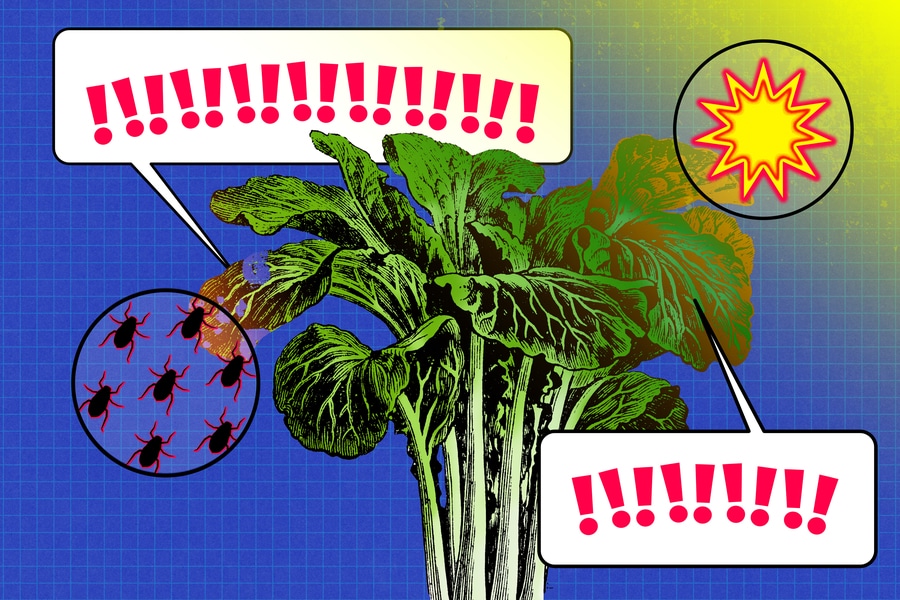Researchers work to boost plant immunity against the heat as population growth demands more food.
When temperatures get too high, humans are not the only ones who feel the burn. Heat stress takes a massive toll on the plants people depend on for food and resources as well. Certain plant defenses are not equipped to handle high temperatures, making them more vulnerable to pathogens and insect pests.
“Model results for areas of Europe and North America, associated with the severe heat waves in Chicago in 1995 and Paris in 2003, show that future heat waves in these areas will become more intense, more frequent and longer lasting in the second half of the 21st century,” shared a study from the American Association for the Advancement of Science.
Impacts of plant pests and diseases have been felt across the world, with a loss of up to 40% of crop production globally, according to the U.N. Food and Agriculture Organization. This costs the global economy over $220 billion each year.
Scientists believe they have identified a protein in plant cells that points to why immunity falters when temperatures rise, and have discovered how to reverse the loss and boost plant defenses, according to a release from Duke University.
Understanding the Molecular Foundation
Scientists have known that above-average temperatures impact a plant’s ability to create salicylic acid, a defense hormone that activates the immune system and prevents invaders from causing too much damage. But researchers did not fully understand the molecular foundation of this immunity meltdown.
In a 2017 study, Sheng-Yang He, Duke University biologist, and Bethany Huot, then graduate student, discovered even short heat waves can greatly impact hormone defenses in Arabidopsis thaliana plants, making them more susceptible to infection by the bacterium Pseudomonas syringae.
Normally, levels of salicylic acid in plant leaves increase 7-fold to prevent bacteria from spreading when attacked by pathogens. When temperatures surpass 86 degrees for two days, plants are unable to produce enough defense hormones to fight infection, shared the release.
“Plants get a lot more infections at warm temperatures because their level of basal immunity is down,” said He. “So, we wanted to know, how do plants feel the heat? And can we actually fix it to make plants heat-resilient?”
Around that time, a different team discovered that phytochromes, a molecule in plant cells, act as internal thermometers, allowing plants to sense warmer temperatures and activate growth and flowering. This brought up a crucial question for He: “Could these same heat-sensing molecules be what’s knocking down the immune system when things warm up, and be the key to bringing it back?”
To test their theory, researchers infected normal and mutant plants whose phytochromes were active regardless of temperature with P. syringae bacteria. The plants were grown at 73 and 82 degrees. The phytochrome mutants still couldn’t produce enough salicylic acid in high temperatures, disproving the theory.
Gene CBP60g: The Missing Piece
Co-first authors Danye Castroverde and Jonghum Kim dedicated several years to conducting similar experiments with various gene suspects. Each time, the mutant plants became sick during warm spells, so they implemented a different strategy.
Scientists used next-generation sequencing to analyze gene readouts in infected Arabidopsis plants at standard and raised temperatures. The test found that many of the genes suppressed at higher temperatures were controlled by the gene CBP60g.
“The CBP60g gene acts like a master switch that controls other genes, so anything that downregulates or ‘turns off’ CBP60g means lots of other genes are turned off, too — they don’t make the proteins that enable a plant cell to build up salicylic acid,” explained the release.
Further research proved the cellular machinery required to begin reading out genetic instructions in the CBP60g gene can’t assemble properly when the temperature is too hot, resulting in failure of the plant’s immune system. Mutant Arabidopsis plants with the CBP60g gene always “switched on” kept defense hormone levels up and held off bacteria, even under heat stress.
Researchers then discovered a way to manipulate heat-resilient plants to activate the CBP60g switch only when in danger, preventing a stunt in growth. This is critical to increase plant protection defenses without decreasing crop yields.
These findings could be beneficial for food supplies impacted by climate change, believes He.
What Does This Mean for Future Food Security?
In order to impact future food security, the strategy to protect immunity used in Arabidopsis plants must work in crops as well, according to He.
Fortunately, the team revealed that elevated temperatures had a similar effect on the salicylic acid defenses in tomato, rapeseed and rice. Follow-up experiments in rapeseed have shown promising results thus far, shared the release.
“We were able to make the whole plant immune system more robust at warm temperatures,” said He. “If this is true for crop plants as well, that’s a really big deal because then we have a very powerful weapon.”
Read More About Efforts Towards Plant Health:
May 12 Marks the International Day of Plant Health
New Biological Portfolio Offers Nutrient Efficiency, Plant Health
Gene Search to Combat Heat Stress in Canola
Plant Scientists Study the Interaction of Heat Stress Responses in Corn













